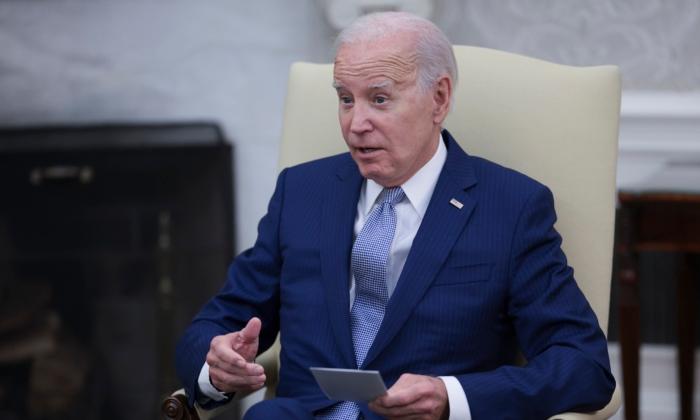In 2003, Democrats and Republicans had near equal views on the federal government’s power, with about 50 percent saying it had too much power.
Today, there is more than a 40-point difference, with 73 percent of Republicans saying the federal government has too much power while only 31 percent of Democrats say the same. Both these figures are lower than the poll results from 2013 after former President Barack Obama took office for his second term.
This comes as another recent Gallup poll revealed that the majority of Americans find the Biden administration’s ethics to be subpar.
About four in 10 said top Biden administration officials’ ethical standards were excellent (8 percent) or good (34 percent), while the majority (55 percent) said they were not good (18 percent) or poor (37 percent). This was overall lower than the ethics scores from when President Joe Biden first took office and is similar to job approval ratings, where President Biden hovers around 40 percent.
“It’s notable that Biden and Trump are the only presidents whose administrations’ ethics have received more negative than positive reviews,” the report reads.
Here, again, the vote varied widely along partisan lines: Just 6 percent of Republicans said the officials were ethical while 84 percent of Democrats voted the same.
Responses were partisan in previous years as well, but never so marked. During the Clinton years, 33 of Republicans said officials were ethical, while 83 percent of Democrats did. This flip-flopped under the Bush years, where 86 percent of Republicans said officials were ethical, while 27 percent of Democrats did. The gap widened under the Obama administration, with only 19 percent of Republicans saying officials were ethical while 81 percent of Democrats responded the same.
Even in the Trump years, approval of officials’ ethics hadn’t gone as low as 6 percent from the opposing party: 11 percent of Democrats said officials were ethical while 74 percent of Republicans voted the same.
Big Partisan Gap on Environment
Environment-related policy is also met with severe partisan disagreement.Gallup selected 24 issues in the survey, and “protecting the environment has priority over energy development” reflected the biggest gap with 55 points: 81 percent of Democrat-leaning voters responded in favor, while only 26 percent of Republican-leaning voters said the same.
In a similar vein, “human activity is the main cause of global warming” had the highest Democrat-leaning response rate at 88 percent, with Republican-leaning voters responding with a 52-point gap at 37 percent. “Worry great deal or fair amount about global warming” showed similar results at 87-35.
“Government should ensure that everyone has healthcare” tied for most polarizing, with 85 percent of Democrat-leaning voters responding in favor while only 30 Republican-leaning voters said the same.
“Gun laws should be stricter” also saw similar gaps, at 84-32 with Democrat-leaning voters in favor.
Polarization
Other poll data show Americans hold similar views on Congress and the Supreme Court.The 92nd Congress, in 1971-1972, held 160 moderates, compared to around two dozen today, Pew notes. And since the 70s, parties have consistently trended toward the left and right, and the middle has all but vanished.
“Democrats on average have become somewhat more liberal, while Republicans on average have become much more conservative,” it writes.
According to Gallup data, Democrats have moved further left than Republicans have moved right.
The trend has been geographic and demographic as well; the analysis found that nearly half of House Republicans came from states in the South, and nearly half of House Democrats were racial minorities.
“Over time, though, Southern Democrats became both fewer in number and more liberal–to the point where today, they account for only 22% of the House Democratic caucus,” the report reads.
However, the majority of bills tend to pass with bipartisan support. Despite polarization, this is the norm, as it is otherwise impossible to pass legislation solely along party lines without a lopsided House and Senate both.
The 117th Congress passed 59.3 percent of bills with bipartisan support, according to Quorum data.





